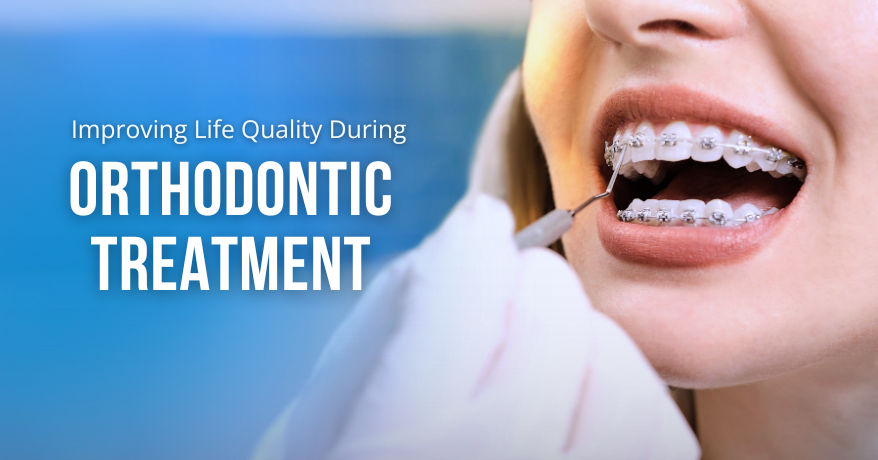Menu

Maintaining good oral hygiene and oral health is essential for everyone, but it becomes even more crucial for orthodontic patients. Whether undergoing treatment with braces, aligners, or other orthodontic appliances, these patients face unique challenges in keeping their mouths clean and healthy. Failure to do so can lead to various issues such as tooth decay, gum disease, and even prolonged treatment duration.
In this article, we will explore the precautions and measures that orthodontic patients should take to ensure optimal oral hygiene and oral health throughout their treatment journey.
1. Symptomatic relief: The initial few days after starting the fixed orthodontic treatment can be uncomfortable.
a. You can take an over-the-counter pain reliever like ibuprofen or
paracetamol an hour before the orthodontist appointment so that the pain reliever will have started working by the time your orthodontic
wires start exerting pull on your teeth.
2. You may require mucosal surface anesthesia (numbing the skin surface inside the mouth) to relieve pain from the braces hurting the soft tissue surfaces.
a. Surface anesthetic tube, like Mucopain for localized areas that develop minor injuries
b. Surface anesthetic & analgesic rinse like Coolora for multiple areas/ full mouth injuries.
c. Daily oral hygiene: Maintaining a clean mouth is a challenge in the presence of braces and wires. You will require a specialized toothbrush, like Thermoseal Ortho, with bristles customized to clean the wires and tooth surfaces simultaneously during the orthodontic treatment.
3. However, the most challenging areas to clean are the areas a. between the wire and tooth: Use a proxa-brush and a water flosser. b. between the teeth: Use a proxa-brush and a water flosser.
4. Gum health and chemical plaque control: Patients in whom toothbrushes are not enough to provide sufficient plaque control and those with a high risk of gum infection and bleeding need extra care with chemical plaque control: Hexidine (0.2%) mouthwash daily use with 1:1 dilution (effective concentration 0.1%)
5. For swelling of soft tissues (gums) between teeth
a. Proxa + Hexigel (Proxa brush will carry the gel between teeth) b. Proxa+ Heximetro (Proxa brush will carry the gel between teeth) 6. High risk of dental caries: Patients with high caries risk need extra care
a. In-office care by the dentist: The dentist should apply in-office fluoride varnish, such as Fluoritop varnish at the start, during, and after the orthodontic treatment.
b. Home- care by the patient: Remin toothpaste: Daily toothpaste to reverse the orthodontic white spots by remineralization.
i. Thermoseal Ortho: Daily toothbrush for the entire duration of ortho treatment
ii. Proxa brush: Daily care to carry Remin toothpaste to areas where a brush can’t reach.
iii. Fluoritop mouthwash: to confer protection from caries in areas a brush can’t reach.
iv. Plak-off water flosser: for easy & efficient daily care and oral hygiene maintenance.
7. Aligner hygiene & daily care: Aligners have become highly popular nowadays. Many people believe that clear aligners are more hygienic and cleaner, and won’t lead to dental problems, such as white spot lesions (WSLs). While they are easy to remove, patients shouldn’t neglect oral hygiene due to some inherent risk factors associated with aligners.
a. Wearing aligners reduces natural salivary flow and the self-cleansing action of orofacial tissues.
b. Additionally, the use of composite attachments covering a significant portion of the tooth surface increases the risk of WSLs, especially in patients who consume sugary beverages without removing the aligners.
c. Therefore, it’s advisable to use a remineralizing toothpaste, such as Remin, and a fluoride mouthwash, such as Fluoritop.
d. Aligners, even if removed for eating and drinking, can still gather debris. Therefore, it is important to clean them daily by soaking them in solutions prepared by using effervescent tablets such as Clinsodent.
In conclusion, the journey to achieving the best smile and appearance with orthodontic treatment requires more than just the placement of braces or aligners. It demands a commitment to maintaining excellent oral hygiene and oral health practices. By following the precautions and measures outlined in this article, orthodontic patients can minimize the risks of complications and ensure their treatment progresses smoothly and efficiently. Remember, a healthy smile is not just about aesthetics—it’s also about overall well-being. So, prioritize your oral hygiene, adhere to your orthodontist’s recommendations, and enjoy the journey towards a healthier, more beautiful smile.


| PRODUCTS | QTY | PRICE | VALUE in INR |
|---|
| PRODUCTS | QTY | PRICE | VALUE in INR |
|---|